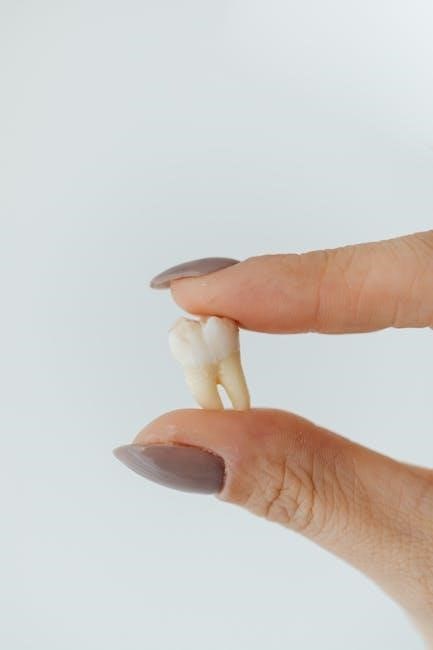Overview of Post-Operative Instructions for Tooth Extraction
Post-operative instructions after tooth extraction are crucial for promoting healing and preventing complications. Patients should expect bleeding, swelling, and discomfort, with guidance on pain management and protecting the surgical site.
1.1 Importance of Following Instructions
Following post-operative instructions after tooth extraction is essential for ensuring proper healing, minimizing complications, and reducing the risk of infection or dry socket. Adhering to guidelines helps protect the blood clot, manage pain, and prevent prolonged recovery. Ignoring instructions can lead to discomfort, swelling, or further treatment needs. Patients must prioritize rest, avoid harmful habits like smoking, and maintain oral hygiene to promote healing. Compliance with instructions ensures a smooth recovery and prevents potential issues, making it crucial for achieving optimal results after the procedure.
1.2 General Expectations After Surgery
2.1 First 24 Hours After Extraction
The first 24 hours after tooth extraction are critical for healing. Patients should bite on gauze for 30-60 minutes to control bleeding and avoid spitting, rinsing, or using straws. A soft diet is recommended, and smoking or alcohol should be avoided. Applying an ice pack can reduce swelling and discomfort. Pain medication should be taken as directed, and rest is essential. Avoid strenuous activities to prevent dislodging the blood clot. Keeping the head elevated can also help minimize swelling and promote recovery during this initial healing period.

Immediate Post-Operative Care

Immediate post-operative care involves biting on gauze for 30-60 minutes to control bleeding, avoiding spitting or rinsing, and applying ice to reduce swelling. Rest is essential.
The first 24 hours are critical for healing. Avoid spitting, rinsing, or using a straw to prevent disturbing the blood clot. Bite on gauze for 30-60 minutes to control bleeding. Apply an ice pack to reduce swelling. Rest with your head elevated and avoid strenuous activities. Do not smoke or consume carbonated/alcoholic beverages. Gently brush teeth, avoiding the extraction site. Pain management should start before anesthesia wears off. Follow all instructions carefully to ensure proper healing and minimize complications.
2.2 Managing Bleeding
Bleeding is common after extraction and may last up to 24 hours. Bite firmly on gauze for 30-60 minutes post-procedure. Replace with fresh gauze if bleeding continues. Avoid spitting, rinsing, or vigorous movements, as they can dislodge the blood clot. Rest quietly with your head elevated to reduce bleeding. If bleeding persists, apply pressure with a moistened tea bag or gauze for another 30 minutes. Contact your dentist if heavy bleeding continues beyond a few hours, as it may require further intervention.
2.3 Pain Management
Pain management is crucial for a comfortable recovery. Take prescribed pain medication as directed, starting before the anesthesia wears off. Over-the-counter options like ibuprofen may be recommended. Monitor pain levels and adjust medication accordingly. If pain worsens or persists despite medication, contact your dentist. Avoiding strenuous activities and applying ice packs can also help reduce discomfort. Gently biting on gauze may alleviate minor pain. Follow your dentist’s specific instructions for medication use to ensure proper healing and minimize post-operative discomfort effectively.

Managing Discomfort and Swelling
Swelling is normal after extraction, peaking around 3-4 days. Use ice packs to reduce swelling and discomfort. Monitor swelling and apply ice as directed to aid recovery.
3.1 Using Ice Packs
Apply an ice pack to the affected area immediately after extraction to minimize swelling and discomfort. Use it alternately, 20 minutes on and 20 minutes off, especially within the first 12 hours. This helps reduce inflammation and eases pain. Continue as needed for the next 24-48 hours, switching to a warm compress if swelling persists. Always place a cloth between the ice and skin to avoid irritation; Consistent use of ice packs can significantly reduce post-operative swelling and promote faster healing.
3.2 Monitoring Swelling
Swelling after tooth extraction is normal and typically reaches its peak within 3-4 days. It should subside within 7 days. Monitor the area for any unusual increases in swelling after 48 hours, as this may indicate complications. If swelling is accompanied by fever, redness, or severe pain, contact your dentist promptly. Keep your head elevated to reduce swelling, and avoid strenuous activities. Applying ice packs during the first 24 hours can help minimize inflammation. If swelling persists or worsens, seek professional advice to ensure proper healing and rule out infection.
3.4 Managing Pain with Medication
Pain after tooth extraction can be managed with prescribed or over-the-counter medications. Start taking pain relievers before the anesthesia wears off to minimize discomfort. Follow the dosage instructions provided by your dentist or on the medication label. If pain increases despite medication, contact your dentist for stronger prescription options. Avoid alcohol and do not mix medications without professional advice. Monitor for side effects and adjust as needed. Proper medication use ensures comfort during the healing process and prevents unnecessary distress.

Oral Hygiene Practices
Good oral hygiene promotes healing and prevents infection. Gently rinse with warm salt water after meals and brush teeth softly, avoiding the extraction site.
4.1 Rinsing with Salt Water
Rinsing with warm salt water is essential for keeping the surgical site clean and promoting healing. Start rinsing gently 24 hours after extraction, using 1 teaspoon of salt in 8 ounces of warm water. Rinse 3-4 times daily, especially after meals, to remove food particles and reduce bacteria. Avoid vigorous rinsing to prevent dislodging the blood clot. Continue this practice for 1-2 weeks or as directed by your dentist. This helps prevent infection and supports the healing process without irritating the extraction site.
4.2 Brushing Teeth Gently
Brushing teeth gently is crucial to maintain oral hygiene without disrupting the healing process. Start brushing the day after surgery, using a soft-bristled toothbrush. Gently clean all teeth except the extraction site, avoiding any vigorous motion that could dislodge the blood clot. Avoid brushing directly over the surgical area for 1-2 weeks. This ensures the site heals properly and prevents infection. Regular, gentle brushing helps maintain cleanliness and promotes recovery, while being mindful to avoid irritating the sensitive area around the extraction site;
4.3 Avoiding Certain Oral Habits
Avoiding specific oral habits is essential to protect the extraction site and promote healing. Refrain from smoking, as it can delay recovery and increase the risk of complications. Avoid using straws or spitting forcefully, as these actions can dislodge the blood clot, leading to a dry socket. Additionally, do not suck on the extraction site or engage in any activity that creates negative pressure in the mouth. These precautions should be followed for at least 24 hours and ideally up to 72 hours post-surgery to ensure proper healing and minimize the risk of infection or prolonged recovery.

Dietary Recommendations
Stick to soft foods like yogurt, mashed potatoes, and scrambled eggs for the first few days; Avoid hard, sticky, or sharp foods that could irritate the site.
5.1 Eating Soft Foods
A soft food diet is essential after tooth extraction to minimize discomfort and protect the surgical site. Opt for foods like yogurt, scrambled eggs, mashed potatoes, and soups. These items are gentle on the mouth and reduce irritation. Avoid hard, crunchy, or sticky foods that could dislodge the blood clot or damage the healing tissue. Incorporate nutrient-rich options to support recovery, such as smoothies or pureed vegetables. Staying hydrated with water or herbal teas is also crucial. A soft food diet typically continues for 3-5 days, gradually introducing more solid foods as healing progresses and discomfort subsides.
5.2 Avoiding Hard or Sticky Foods
Avoiding hard or sticky foods is crucial after tooth extraction to prevent dislodging the blood clot and delaying healing. Foods like nuts, hard candies, and crunchy vegetables should be avoided for at least 3-5 days; Sticky foods such as caramel or gum can also disrupt the healing process. These foods can irritate the surgical site, leading to discomfort or complications like dry socket. Opt for soft, easy-to-chew options instead. Gradually reintroduce harder foods as healing progresses and discomfort subsides, typically around 7-10 days post-extraction.
5.3 Staying Hydrated
Staying hydrated is essential for recovery after tooth extraction. Drink plenty of fluids like water, clear broths, or herbal teas to maintain hydration and support healing. Avoid alcohol, carbonated beverages, and caffeine for 24 hours, as they can interfere with clot formation. Sip liquids gently and avoid using straws, which can dislodge the blood clot. Proper hydration helps prevent dry mouth and promotes overall comfort during recovery.
5.4 Avoiding Alcohol and Carbonated Drinks
Avoiding alcohol and carbonated drinks is crucial after tooth extraction to prevent complications. Alcohol can interfere with blood clot formation, increasing the risk of dry socket. Carbonated beverages can dislodge the clot and irritate the extraction site. Both can delay healing and cause discomfort. Patients should abstain from these drinks for at least 24 hours and ideally avoid them for several days. Stick to water, clear broths, or herbal teas to stay hydrated without compromising recovery.
Activity Level and Rest
Rest is essential after tooth extraction to promote healing. Elevate your head to reduce swelling and avoid strenuous activities for 24-48 hours to protect the blood clot.
6.1 Importance of Rest
Rest is crucial after tooth extraction to ensure proper healing. Avoid strenuous activities like exercise or heavy lifting for 24-48 hours. Elevating your head while resting can reduce swelling and promote recovery. Overexertion can dislodge the blood clot, leading to complications such as dry socket. Patients should prioritize relaxation and avoid any actions that increase heart rate or blood pressure. Adequate rest helps the body recover faster and minimizes the risk of post-operative issues. By adhering to these guidelines, patients can support their healing process effectively.
6.2 Avoiding Strenuous Activities
Avoiding strenuous activities is essential after tooth extraction to prevent complications. Activities like exercise, heavy lifting, or bending can dislodge the blood clot, leading to a dry socket. Strenuous tasks increase blood pressure and heart rate, which may cause excessive bleeding or delay healing. Patients should refrain from such activities for at least 24-48 hours. Light tasks, such as reading or watching TV, are acceptable. Overexertion can undermine the healing process, so it’s crucial to prioritize a calm and relaxed environment during the initial recovery phase.
6.3 Elevating the Head

Elevating the head is recommended to reduce swelling and promote healing after tooth extraction. Patients should sleep with their head slightly elevated using extra pillows for the first 24-48 hours. This position helps reduce blood flow to the surgical site, minimizing swelling and discomfort. Elevating the head also prevents blood from pooling near the extraction site, which can interfere with clot formation. Maintaining this posture during rest is a simple yet effective way to support the recovery process and ensure optimal healing outcomes.
Managing the Surgical Site
Protecting the surgical site is essential for healing. Avoid disturbing the blood clot, as it aids in recovery. Monitor for signs of complications like dry socket.
7.1 Protecting the Blood Clot
Protecting the blood clot is vital for proper healing after tooth extraction. immediately after the procedure, bite down on the gauze for 30-60 minutes to control bleeding. Avoid activities like rinsing, spitting, or using a straw for 24 hours, as these can dislodge the clot. Smoking and drinking carbonated or alcoholic beverages should also be avoided. After the first day, gentle rinsing with warm salt water can help keep the area clean without disturbing the clot. If the clot is lost prematurely, it may lead to complications like dry socket, which can delay recovery and cause discomfort.
7.2 Avoiding Disturbance of the Site
Avoiding disturbance of the surgical site is essential to prevent complications and promote healing. For the first 24 hours, refrain from spitting, rinsing vigorously, or using a straw, as these actions can dislodge the blood clot. Smoking should also be avoided, as it can interfere with healing and increase the risk of dry socket. Gentle rinsing with warm salt water may be introduced after the first day, but avoid direct pressure or suction near the extraction site. Protecting the site ensures the blood clot remains intact, which is critical for proper recovery and minimizing the risk of infection or prolonged discomfort.
7.3 Signs of Dry Socket
Signs of dry socket include severe pain, which may radiate to the ear or face, and the disappearance of the blood clot, leaving the socket dry. Patients might also experience bad breath or a bad taste. These symptoms usually appear a few days after extraction. If you notice these signs, contact your dentist promptly for treatment to prevent further complications and ensure proper healing.

Follow-Up Care
Follow-up care ensures proper healing and addresses concerns. Attend scheduled appointments for suture removal and to monitor recovery progress, promoting optimal outcomes after tooth extraction.
8.1 Suture Removal
Suture removal is a routine part of the recovery process after tooth extraction. Stitches are typically removed 7-10 days post-surgery, depending on the procedure’s complexity and healing progress.
Patients should attend a follow-up appointment for suture removal to ensure proper healing. The process is usually quick and causes minimal discomfort. After removal, maintain good oral hygiene to prevent infection.
Avoid chewing on the surgical site until fully healed. Continue following post-operative instructions to promote optimal recovery and minimize complications.
8.2 Attending Follow-Up Appointments
Attending follow-up appointments is essential for monitoring healing progress and ensuring proper recovery after tooth extraction. Patients should schedule and attend all recommended post-operative check-ups with their dentist. These visits allow the dentist to assess the healing of the extraction site, remove sutures if necessary, and address any concerns or complications. Follow-up care helps prevent infection, promotes healing, and ensures the surgical site is developing as expected. Patients should arrive early, be prepared to discuss their recovery experience, and ask questions to clarify any uncertainties about their care.

Emotional and Mental Well-Being
Managing anxiety and fear is crucial for a smooth recovery. Patients should stay calm, follow instructions, and seek support to reduce stress and promote mental comfort.
9.1 Managing Anxiety
Managing anxiety after tooth extraction is essential for a smooth recovery. Patients may feel apprehensive about pain, swelling, or complications. Deep breathing exercises and distraction techniques can help calm nerves. Staying informed about the recovery process reduces uncertainty and fear; Prescribed pain medications and clear instructions from the dentist can alleviate concerns. Encourage open communication with the dental team to address any worries. A supportive environment and reassurance from family or friends can also ease anxiety. Proper mental well-being ensures a more comfortable and effective healing process.
9.2 Coping with Fear of Swelling or Pain
Fear of swelling or pain after tooth extraction can be managed by understanding the recovery process. Applying ice packs as directed reduces swelling, while following medication schedules alleviates pain. Keeping the surgical site clean and avoiding strenuous activities minimizes discomfort. Staying informed about normal symptoms and their duration helps reduce anxiety. Encourage patients to express concerns to their dentist for personalized reassurance. A supportive environment and positive mindset can significantly ease fears, ensuring a smoother recovery and better overall well-being.

Emergency Situations
Excessive bleeding, severe swelling, or a high fever after tooth extraction are emergencies. Apply gauze for bleeding, seek medical evaluation for swelling, and contact your dentist immediately for persistent symptoms.
10.1 Excessive Bleeding
Excessive bleeding after tooth extraction is an emergency. If bleeding persists despite gauze application, apply firm pressure with a clean cloth or gauze for 30-60 minutes. Elevate your head and rest quietly. Avoid strenuous activities, bending, or lifting. If bleeding continues uncontrollably, contact your dentist immediately. Excessive bleeding may require additional measures, such as sutures or cauterization. Monitor for signs of blood loss, including dizziness or pale skin. Seek urgent medical attention if bleeding does not subside within a few hours, as it can lead to serious complications.
10.2 Severe Swelling
Severe swelling after tooth extraction may indicate complications. Apply ice packs alternately (20 minutes on, 20 minutes off) to reduce swelling. Elevate your head while resting. If swelling persists beyond 3-4 days or worsens, contact your dentist. Severe swelling can signal infection or prolonged healing. Monitor for redness, warmth, or pus around the site. Immediate medical attention is essential if swelling is accompanied by fever or difficulty breathing, as it may indicate a serious infection requiring antibiotics or further treatment.
10.3 High Fever
A high fever following tooth extraction is uncommon but may indicate infection. If your temperature exceeds 101.5°F, contact your dentist immediately. Fever can signal complications like infection or dry socket. Monitor for accompanying symptoms such as chills, redness, or pus near the surgical site. Continue taking prescribed pain medication and antibiotics as directed. Apply a cold compress to reduce discomfort. Persistent or rising fever requires urgent medical attention, as it may necessitate additional treatment or adjustment of antibiotics to ensure proper healing and prevent further complications.
Long-Term Recovery
Long-term recovery involves complete healing of the extraction site, typically taking 6-8 months. Proper care ensures the area heals correctly, allowing normal activities to resume without complications.
11.1 Healing Timeline
The healing process after tooth extraction occurs in stages, with initial healing taking 1-2 weeks. Gum tissue typically heals within 3-4 weeks, while complete bone healing may take 6-8 months. The blood clot forms in the first 24 hours, and its protection is crucial for proper healing. Patients can resume normal activities within a few days, but full recovery depends on adherence to post-operative care. Proper wound care ensures the site heals without complications, allowing for the return of normal dental function and aesthetics over time.
11.2 Returning to Normal Activities
Most patients can resume normal activities within a few days after tooth extraction. However, strenuous exercises or heavy lifting should be avoided for 24-48 hours to prevent dislodging the blood clot. Gentle routines, such as light walking or desk work, are usually permissible. Avoid smoking, drinking through straws, or spitting forcefully, as these actions can disrupt the healing process. Patients should also avoid consuming hard, crunchy, or sticky foods until the site is fully healed. Gradually returning to normal activities ensures the surgical site heals properly without complications.
11.3 Ensuring Proper Healing
Proper healing after tooth extraction requires careful attention to post-operative instructions. Protecting the blood clot is essential, as it aids in wound closure and prevents complications like dry socket. Avoiding smoking, vigorous rinsing, and spitting helps maintain the clot. Using ice packs in the first 24 hours can reduce swelling and promote healing. Gentle saltwater rinses after 24 hours keep the site clean without dislodging the clot. Avoiding hard or sticky foods prevents irritation, while adhering to prescribed pain medication ensures discomfort is managed without interfering with recovery. Follow-up appointments are crucial to monitor progress and ensure the site is healing as expected.

